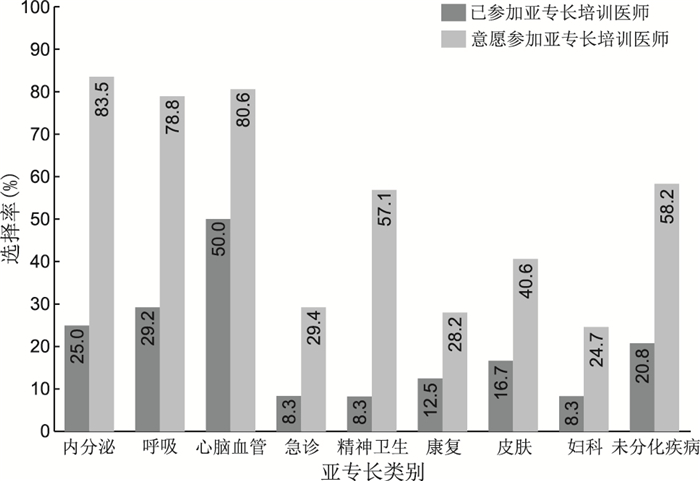Development status of General Practitioner with Special Interest in comprehensive hospitals: a survey
-
摘要:
目的 了解国内综合医院全科医学科亚专长全科医师(general practitioner with special interest, GPwSI)发展现状。 方法 于2022年4月,通过网络对国内综合医院全科医师进行调查,调查内容包括全科医师的基本信息、亚专长发展现状、未来发展亚专长意愿及培训需求等。 结果 共收回问卷203份,其中有效问卷200份,有效率为98.5%。200名全科医师年龄为(37.8±9.3)岁,男性83人(41.5%),女性117人(58.5%),参加过亚专长培训的全科医师24人(12.0%),未参加过全科亚专长培训176人(88.0%)。与未参加过亚专长培训的全科医师组相比,参加过亚专长培训组的全科医师从事全科工作年限更长(P < 0.05)。在参加过亚专长培训医师的发展方向上,最常见的是心脑血管亚专长(50.0%,12/24);在意愿发展亚专长方向上,最常见的是内分泌亚专长(83.5%,142/170)。在亚专长培训起始阶段问题上,与副主任医师及以上组比较,主治医师及以下更愿意尽早开展亚专长培训(P < 0.05),且更倾向于自我指导(P < 0.05)。 结论 现阶段我国部分综合医院全科医学科虽已有亚专长全科医师,但仍未有完善的培训体系及认证模式。因此当前首先应建立全科医师亚专长培训发展与认证机构,确定认证标准;各地区可因地制宜积极开展全科医师亚专长培训。 Abstract:Objective The purpose of this study is to understand the development status of General Practitioner with Special Interest (GPwSI) in comprehensive hospitals in China. Methods In April 2022, a questionnaire was sent through the Internet to a large number of general practitioners in comprehensive hospitals in China. The questionnaire included the basic information of general practitioners, the development status of GPwSI in comprehensive hospitals, and the willingness and training needs of general practitioners to develop general specialties, and so on. Results A total of 203 questionnaires were collected, of which 200 were valid, with an effective rate of 98.5%. Among the 200 general practitioners, the mean age was (37.8±9.3) years, 83 (41.5%) were male, 117(58.5%) were female, 24 (12.0%) had participated in general special interests training, and 176(88.0%) had not. Compared with the group who had not participated in any special interest training, the group of general practitioners who had participated in special interest training had longer working years (P < 0.05). Among those who had participated in special interests training, the most important specialty is cardiovascular and cerebrovascular (50.0%, 12/24). While, those who are willing to develop general special interests, the most important is endocrinology (83.5%, 142/170). Regarding the start of general specialty training, compared with the group of assistant chief physician and above, the attending physician and below are more willing to start training, as early as possible (P < 0.05), and prefer self-study (P < 0.05). Conclusion At present, some of comprehensive hospitals in China have GPwSI, however, there is still no complete training system and certification mode. Therefore, we should first establish a general special interest training and certification organization, and determine the certification standards at present. Each region chooses its own training mode. -
表 1 参加过亚专长培训组和未参加过亚专长培训组的全科医师基本信息比较
Table 1. Comparison of basic information between general practitioners who have participated in subspecialty training groups and those who have not
组别 人数 性别[人(%)] 年龄(x±s,岁) 学历[人(%)] 职称[人(%)] 男性 女性 硕士研究生及以上 本科及以下 副主任医师及以上 主治医师及以下 参加过亚专长培训组 24 11(45.8) 13(54.2) 39.2±9.2 12(50.0) 12(50.0) 13(54.2) 11(45.8) 未参加过亚专长培训组 176 72(40.9) 104(59.1) 37.6±9.4 68(38.6) 108(61.4) 76(43.2) 100(56.8) 总计 200 83(41.5) 117(58.5) 37.8±9.3 80(40.0) 120(60.0) 89(44.5) 111(55.5) 统计量 0.211a 0.793b 1.136a 1.032a P值 0.646 0.429 0.286 0.310 组别 人数 参加工作年限[M(P25, P75),年] 从事全科年限[M(P25, P75),年] 培训类型[人(%)] 5+3全科住培 助理全科住培 全科转岗 以上均未参加 参加过亚专长培训组 24 18(5, 24) 6(4, 9) 9(37.5) 0 7(29.2) 8(33.3) 未参加过亚专长培训组 176 11(4, 22) 5(3, 8) 67(38.1) 5(2.8) 76(43.2) 28(15.9) 总计 200 11(4, 22) 5(3, 8) 76(38.0) 5(2.5) 83(41.5) 36(18.0) 统计量 -1.089c -1.991c 5.246a P值 0.276 0.047 0.155 注:a为χ2值,b为t值,c为Z值。 表 2 参加过亚专长培训的全科医师一般情况(n=24)
Table 2. General information of general practitioners who have participated in sub-specialty training (n=24)
项目 人数 百分比(%) 全科亚专长培训阶段 目前已是亚专长全科医师 15 62.5 正在参加亚专长培训 9 37.5 固定的亚专长临床导师位数 无 10 41.7 1位 5 20.8 2位 3 12.5 大于2位 6 25.0 接诊数与亚专长相关比例 0~25% 7 29.2 25%~50% 8 33.3 50%~75% 7 29.2 >75% 2 8.3 发展亚专长对个人的影响(多选) 增强亚专长疾病的诊治能力 24 100.0 提高个人职业成就感 17 70.8 提高个人劳动收入 6 25.0 没什么用,徒增日常工作量 1 4.2 其他 2 8.3 表 3 有发展亚专长意愿的全科医师特征及培训需求
Table 3. Characteristics and training needs of general practitioners with a desire to develop subspecialties
组别 人数 年龄(x±s,岁) 培训类型[人(%)] 开始培训的阶段[人(%)] 理论培训方式[人(%)] 全科住培 全科转岗 以上均未参加 住培期间 住培结束后 晋升主治以后 任何阶段 线下培训 线上培训 线上+线下 自学 主治医师及以下 95 31.2±5.8 63(66.3) 21(22.1) 11(11.6) 26(27.4) 29(30.5) 28(29.5) 12(12.6) 14(14.7) 13(13.7) 64(67.4) 4(4.2) 副主任医师及以上 75 46.0±5.8 5(6.7) 54(72.0) 16(21.3) 10(13.3) 10(13.3) 41(54.7) 14(18.7) 6(8.0) 8(10.7) 59(78.7) 2(2.7) 总计 170 37.8±9.4 68(40.0) 75(44.1) 27(15.9) 36(21.2) 39(22.9) 69(40.6) 26(15.3) 20(11.8) 21(12.4) 123(72.4) 6(3.5) 统计量 -16.519a 63.442b 16.851b 2.948b P值 < 0.001 < 0.001 0.001 0.400 组别 人数 实践培训方式[人(%)] 培训时长[人(%)] 精进方式[人(%)] 跟师坐诊 病房轮岗 导师协同诊治 1年内 1年以上 自我自导 小组学习 参与专科理论学习 专科门诊跟师坐诊 专科病房进行 主治医师及以下 95 67(70.5) 68(71.6) 68(71.6) 60(63.2) 35(36.8) 40(42.1) 66(69.5) 75(78.9) 67(70.5) 77(81.1) 副主任医师及以上 75 56(74.7) 60(80.0) 50(66.7) 53(70.7) 22(29.3) 15(20.0) 45(60.0) 54(72.0) 58(77.3) 63(84.0) 总计 170 123(72.4) 128(75.3) 118(69.4) 113(66.5) 57(33.5) 55(32.4) 111(65.3) 129(75.9) 125(73.5) 140(82.4) 统计量 0.359b 1.598b 0.476b 1.060b 9.358b 1.660b 1.105b 0.998b 0.251b P值 0.549 0.206 0.490 0.303 0.002 0.198 0.293 0.318 0.617 注:a为t值,b为χ2值。 -
[1] 宋双双, 张倩, 谭万娇, 等. 综合性医院建立全科医学科的意义及现状分析[J]. 重庆医学, 2021, 50(12): 2143-2145. https://www.cnki.com.cn/Article/CJFDTOTAL-CQYX202112036.htmSONG S S, ZHANG Q, TANG W J, et al. Analysis of the significance and current situation of establishing the department of general practice in general hospitals[J]. Chongqing Medicine, 2021, 50(12): 2143-2145. https://www.cnki.com.cn/Article/CJFDTOTAL-CQYX202112036.htm [2] 高伟飞, 李琰华, 李俊伟. 基于Blackboard网络教学平台的规培医师全科强化课程建设[J]. 中华全科医学, 2018, 16(12): 2092-2094, 2110. doi: 10.16766/j.cnki.issn.1674-4152.000570GAO W F, LI Y H, LI J W. Construction of general medical reinforcement of residents based on blackboard network teaching platform[J]. Chinese Journal of General Practice, 2018, 16(12): 2092-2094, 2110. doi: 10.16766/j.cnki.issn.1674-4152.000570 [3] 应美珂, 刘颖, 任菁菁. 专科医生对全科医生发展亚专长的态度研究[J]. 中国全科医学, 2019, 22(16): 1936-1939. https://www.cnki.com.cn/Article/CJFDTOTAL-QKYX201916013.htmYING M K, LIU Y, REN J J. The specialists' views on general practitioners with special interests[J]. Chinese General Practice, 2019, 22(16): 1936-1939. https://www.cnki.com.cn/Article/CJFDTOTAL-QKYX201916013.htm [4] YELLAMATY V, BALL L, CROSSLAND L, et al. General practitioners with special interests: an integrative review of their role, impact and potential for the future[J]. Aust J Gen Pract, 2019, 48(9): 639-643. doi: 10.31128/AJGP-02-19-4849 [5] 刘颖, 蒋国平, 任菁菁. 我国全科医生培养现状与发展策略[J]. 中国工程科学, 2019, 21(2): 74-78.LIU Y, JIANG G P, REN J J. Current Status and Development Strategies of General Practitioner Training in China[J]. Engineering Science, 2019, 21(2): 74-78. [6] BRENNAN M E, SPILLANE A J. The breast physician: an example of specialisation in general practice[J]. Med J Aust, 2007, 187(2): 111-114. doi: 10.5694/j.1326-5377.2007.tb01154.x [7] 李帅, 刘颖, 刘娟娟, 等. 综合医院全科医学科住培基地开展全科医师三部曲培养模式的应用[J]. 中国毕业后医学教育, 2021, 5(4): 360-363. https://www.cnki.com.cn/Article/CJFDTOTAL-BHYJ202104018.htmLI S, LIU Y, LIU J J, et al. Application of trilogy training mode for general practitioners in standardized training base of general hospital residents[J]. Chinese Journal Of Graduate Medical Education, 2021, 5(4): 360-363. https://www.cnki.com.cn/Article/CJFDTOTAL-BHYJ202104018.htm [8] BUGAJ T J, VALENTINI J, MIKSCH A, et al. Work strain and burnout risk in postgraduate trainees in general practice: an overview[J]. Postgrad Med, 2020, 132(1): 7-16. [9] 刘颖, 邱艳, 任文, 等. 我国全科医师亚专长培养现状及发展思考[J]. 中华医学教育探索杂志, 2021, 20(4): 406-408.LIU Y, QIU Y, RENG W, et al. Current status and development of the training of general practitioners with special interest(GPSI)in China[J]. Chinese Journal of Medical Education Research, 2021, 20(4): 406-408. [10] 卢崇蓉, 方力争. 综合性医院全科医学学科建设和全科医师培养的探索[J]. 中国毕业后医学教育, 2018, 2(2): 84-87. https://www.cnki.com.cn/Article/CJFDTOTAL-BHYJ201802002.htmLU C R, FANG L Z. The construction of general practice department and training of general practitioners in general hospitals[J]. Chinese Journal of Graduate Medical Education, 2018, 2(2): 84-87. https://www.cnki.com.cn/Article/CJFDTOTAL-BHYJ201802002.htm [11] 吴伟东, 杨凯超, 李开军, 等. 综合性三甲医院全科医学科病房设置探讨[J]. 浙江医学教育, 2019, 18(4): 41-43. https://www.cnki.com.cn/Article/CJFDTOTAL-ZYJT201904014.htmWU W D, YANG K C, LI K J, et al. Discussion on setting of general practice ward in the comprehensive top three hospitals[J]. Zhejiang Medical Education, 2019, 18(4): 41-43. https://www.cnki.com.cn/Article/CJFDTOTAL-ZYJT201904014.htm [12] EL-SHANAWANY I R, WADE C, HOLLOWAY J A. The impact of a general practitioner-led community paediatric allergy clinic: a service evaluation[J]. Clin Exp Allergy, 2019, 49(5): 690-700. [13] MINSHALL I, NELIGAN A. First evidence of the clinical impact of a general practitioner with a special interest in epilepsy[J]. Epilepsy Behav, 2019, 101(Pt A): 106554. DOI: 10.1016/j.yebeh.2019.106554. [14] PURTELL L, WHITING E, MULLER K, et al. Evaluation of a general practitioner with special interest model: lessons learned from staff experiences[J]. Aust J Prim Health, 2022, 28(4): 330-337. [15] 王永晨. 全科医生专长化: 我国全科医生继续教育的新理念[J]. 中华医学教育探索杂志, 2018, 17(5): 433-438. https://www.cnki.com.cn/Article/CJFDTOTAL-SYQY202307036.htmWANG Y C. General Practitioner Specialization: new concept of general practitioner's continuing education in China[J]. Researches in Medical Education, 2018, 17(5): 433-438. https://www.cnki.com.cn/Article/CJFDTOTAL-SYQY202307036.htm [16] 于晓松. 新中国成立70年以来中国全科医学发展与展望[J]. 中华全科医学, 2019, 17(11): 1797-1799. doi: 10.16766/j.cnki.issn.1674-4152.001058YU X S. The development and prospect of chinese general practice since the founding of new China 70 years ago[J]. Chinese Journal of General Practice, 2019, 17(11): 1797-1799. doi: 10.16766/j.cnki.issn.1674-4152.001058 -





 下载:
下载:


